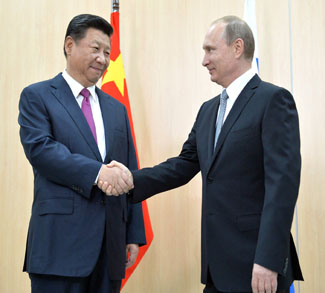The first US presidential debate took place on June 27, and the entire world looked on in 50 shades of wonderment, shock, shame and horror. Regardless of one’s feelings towards the United States or the candidates, two facts came across crystal clear to the entire globe – something is terribly wrong at the top of the US political system and reliable and responsible US world leadership is not to be found.
The following will try and explain the seemingly erratic foreign policy of one of the world’s superpowers, the United States, in Eastern Europe and how this can be explained through the lens of micro-militarism.
NATO Expansion and Support for the Ukraine War
After the election of President Donald Trump in 2016 commentators the world over rang warning bells, fearing that Trump would end ‘the liberal world order’, ‘the American Era’, and ‘American Exceptionalism’. All the dire warnings were off the mark. In fact, all of the above trends have their genesis during earlier presidencies, the culmination point being the current presidency of Joe Biden.
President Clinton began the expansion of NATO in the 1990s. This continued under President Bush, finally receiving strong pushback from President Putin at the now infamous, or prophetic Munich Security Conference speech of 2007. This policy continued under President Obama with credible allegations of US involvement in the Euromaidan protects and eventual overthrow of Ukrainian President Victor Yanukovych. President Trump escalated the Obama administration position, sending Obama administration restricted lethal military aid to Ukraine. This culminated on December 15 2021 under the current Biden presidency, when on the eve of war, Russia sent two draft treaties on European security to Brussels and Washington. The response from NATO and Secretary of State Anthony Blinken were clear: “enter negotiations with Washington and its allies, including Ukraine, or proceed with an invasion and face crushing economic sanctions.” Russia proceeded with its war in Ukraine which continues to bring destruction and mayhem as of the time of this writing.
NATO Secretary-General Jens Stoltenberg plainly admitted that the cause of the current war in Ukraine was a consequence of NATO expansion and Russian fears of said expansion. Stoltenberg then came to the conclusion that the answer to Russian aggression due to NATO-based security fears was simply more NATO expansion, this time along Russia’s borders with Sweden and Finland. Since the outbreak of the war, Washington has not attempted to negotiate or bring an end to the conflict; instead of peace, more lethal weapons have been sent.
Ukraine and Micro-militarism
Historian Alfred McCoy in his book In the Shadows of the American Century: The Rise and Decline of US Global Power argues that in the face of declining returns on economic and diplomatic power, the United States could ‘plunge into ill-advised military adventures that can lead to defeat and disaster.’ A phenomenon historians term micro-militarism, whereby leaders seeking to restore failing and faded power engage in disastrous foreign policy misadventures that lead to the final destruction of their empires. The classic modern example being Britain and France with the Suez Crisis of 1956.
Explanations for US policy toward Russia largely center on neoconservative animus toward Russia, historical animus towards communism and the Soviet Union ,and anger towards Russia over alleged election meddling that brought Trump to power.
The current anger, fear, and hatred toward all things Russia and Russian is an odd phenomenon given that not long ago it was commonplace for US high officials to deride Russia’s weakness. Senate hawk Lindsay Graham noted that ‘Russia’s economy was the size of Italy.’ Former Senator John McCain derided Russia as a ‘gas station masquerading as a country.’ Former President Obama accused Mitt Romney of living in the 1980s and having ‘a Cold War mentality’ during their presidential debate in 2012. President Putin is at the same time portrayed as leader of a dysfunctional, corrupt, and inept state while simultaneously undermining democracies the worldwide and masterminding the hijacking of others spheres of influence. Both cannot be true.
Either way, US political elites choosing to sacrifice hegemony and global leadership on the hill of Ukraine, which holds no strategic value, is an odd conundrum to say the least.
At the outset of the Ukraine war, the United States and its allies levied the widest ranging unilateral-non-UNSC sanctions regime in history. From banning Russian air travel to kicking Russian banks out of the SWIFT payments system to an oil price cap on Russian oil – to date the sanctions policy has been an abject failure. Currently, the West is trying to seize frozen Russian Central Bank assets. Regardless of the rationalization used, seizing these assets stands as nothing more than theft which is in direct contravention of the international legal principle of sovereign immunity.
Losing Battles and Possibly Global Leadership
Initially, Ukraine did well against the Russians in the summer and autumn of 2022, pushing Russia out of Kharkov oblast and Kherson city. Since then, Ukraine has been on receiving end of relentless Russian attritional warfare and as things stand, the future looks bleak for Ukraine on the battlefield. With Zelensky’s peace summit a failure, constant US escalation and a completely failed sanctions regime which has only strengthened Russia militarily and economically, NATO and United States are in danger of strategic defeat.
The gamble to defeat Russia undertaken by Washington and its European allies was a dangerous one. Instead of being all in, support for Ukraine has come in fits and starts. First came sanctions, then money and arms, then HIMARS, then Leopard tanks, then Abrams, now ATACMS, and soon F16s. This trickle of arms has created a Frankenstein army of non-interoperable equipment, but also disadvantaged the Ukrainians. To expect any military to operate and maintain the hodgepodge of equipment sent to Ukraine, not to mention pushback and defeat a much larger adversary without air superiority or air defense would be too much to expect from any NATO force. Nonetheless this is what is expected by Western officials and analysts.
The wider context of the above did not happen in a vacuum. With US sanctions on Chinese entities, the arming of Taiwan, and belligerence towards Russia, a Eurasian Sino-Russia partnership has emerged and strengthened with both leaders declaring theirs to be a ‘friendship without limits nor areas of cooperation.’ This perhaps is an unintended consequence of recent US moves but nonetheless stands as a reminder of the knock on effects of a less than strategically sound foreign policy.
The coming together of the two Eurasian powers presents a formidable force for the Western alliance. Without the Global South on board with sanctions and belligerence toward Russia, the West is largely speaking to itself as evidenced by the signatories to Zelensky’s peace summit communique.
In the current context, micro-militarism would point toward unending hostilities in Ukraine or a fight until one side is fully exhausted and defeated on the battlefield. The West gambled on a quick strike victory over Russia so it could focus on its adversary in Northeast Asia. Instead, it has stumbled into a quagmire that may very well culminate in the end of 400 years of Western dominance of world affairs and a reordering of world power into multipolarity.
The views expressed in this article belong to the author(s) alone and do not necessarily reflect those of Geopoliticalmonitor.com.




